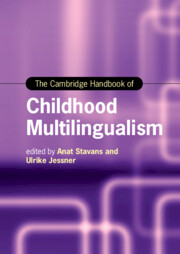41 results
Country Index
-
- Book:
- The Cambridge Handbook of Childhood Multilingualism
- Published online:
- 18 August 2022
- Print publication:
- 25 August 2022, pp 675-676
-
- Chapter
- Export citation
Copyright page
-
- Book:
- The Cambridge Handbook of Childhood Multilingualism
- Published online:
- 18 August 2022
- Print publication:
- 25 August 2022, pp vi-vi
-
- Chapter
- Export citation
Part Six - Multilingual Children’s Landscape
-
- Book:
- The Cambridge Handbook of Childhood Multilingualism
- Published online:
- 18 August 2022
- Print publication:
- 25 August 2022, pp 603-667
-
- Chapter
- Export citation
Part Two - Cognition and Faculties in Multilinguals
-
- Book:
- The Cambridge Handbook of Childhood Multilingualism
- Published online:
- 18 August 2022
- Print publication:
- 25 August 2022, pp 111-254
-
- Chapter
- Export citation
Contents
-
- Book:
- The Cambridge Handbook of Childhood Multilingualism
- Published online:
- 18 August 2022
- Print publication:
- 25 August 2022, pp vii-viii
-
- Chapter
- Export citation
Tables
-
- Book:
- The Cambridge Handbook of Childhood Multilingualism
- Published online:
- 18 August 2022
- Print publication:
- 25 August 2022, pp x-x
-
- Chapter
- Export citation
Multilingualism Is Not Bilingualism +1: An Introduction
-
-
- Book:
- The Cambridge Handbook of Childhood Multilingualism
- Published online:
- 18 August 2022
- Print publication:
- 25 August 2022, pp 1-10
-
- Chapter
- Export citation
Part Four - Language(s) and Literacy of Multilingual Children through Schooling
-
- Book:
- The Cambridge Handbook of Childhood Multilingualism
- Published online:
- 18 August 2022
- Print publication:
- 25 August 2022, pp 353-488
-
- Chapter
- Export citation
Language Index
-
- Book:
- The Cambridge Handbook of Childhood Multilingualism
- Published online:
- 18 August 2022
- Print publication:
- 25 August 2022, pp 677-678
-
- Chapter
- Export citation
Figures
-
- Book:
- The Cambridge Handbook of Childhood Multilingualism
- Published online:
- 18 August 2022
- Print publication:
- 25 August 2022, pp ix-ix
-
- Chapter
- Export citation
Subject Index
-
- Book:
- The Cambridge Handbook of Childhood Multilingualism
- Published online:
- 18 August 2022
- Print publication:
- 25 August 2022, pp 668-674
-
- Chapter
- Export citation
Contributors
-
- Book:
- The Cambridge Handbook of Childhood Multilingualism
- Published online:
- 18 August 2022
- Print publication:
- 25 August 2022, pp xiii-xv
-
- Chapter
- Export citation
Part Five - Socialization in Childhood Multilingualism
-
- Book:
- The Cambridge Handbook of Childhood Multilingualism
- Published online:
- 18 August 2022
- Print publication:
- 25 August 2022, pp 489-602
-
- Chapter
- Export citation
Part Three - Family Language Policy
-
- Book:
- The Cambridge Handbook of Childhood Multilingualism
- Published online:
- 18 August 2022
- Print publication:
- 25 August 2022, pp 255-352
-
- Chapter
- Export citation
About the Editors
-
- Book:
- The Cambridge Handbook of Childhood Multilingualism
- Published online:
- 18 August 2022
- Print publication:
- 25 August 2022, pp xi-xii
-
- Chapter
- Export citation
Acknowledgments
-
- Book:
- The Cambridge Handbook of Childhood Multilingualism
- Published online:
- 18 August 2022
- Print publication:
- 25 August 2022, pp xvi-xviii
-
- Chapter
- Export citation
Part One - Becoming and Being a Multilingual Child
-
- Book:
- The Cambridge Handbook of Childhood Multilingualism
- Published online:
- 18 August 2022
- Print publication:
- 25 August 2022, pp 11-110
-
- Chapter
- Export citation

The Cambridge Handbook of Childhood Multilingualism
-
- Published online:
- 18 August 2022
- Print publication:
- 25 August 2022
Introduction
-
- Book:
- Multilingualism
- Published online:
- 05 February 2015
- Print publication:
- 12 January 2015, pp 1-8
-
- Chapter
- Export citation
Contents
-
- Book:
- Multilingualism
- Published online:
- 05 February 2015
- Print publication:
- 12 January 2015, pp vii-ix
-
- Chapter
- Export citation

